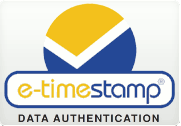Proxy to Timestamp Services
Product Overview
The Proxy allows many employees and internal systems to securely share access to timestamp services. Individual workstations access timestamp services using a customized URL like http://timestamp.companyInternal.com and require no authentication or special software. Timestamp requests are then forwarded along an authenticated connection to the TimeStamp Authority. The Proxy could even be reconfigured later to use on-site hardware or a different timestamp vendor, and there would be no impact to existing users. The software version of the Proxy is free with a one-year volume contact here. The cost for each Proxy hardware device will depend on contract volume and will be less than $500.
How it works
-
Use the SecureTime Proxy to allow internal users to access an external timestamp server without authentication. Therefore, individual clients do not need an account. A shared address is all that is needed to access timestamp services.
-
The Proxy can serve as a temporary or initial method of supplying timestamps to your internal clients. If you change your approach at a later time (for example, you purchase timestamping hardware), then your clients would not need to change the name that they had become accustomed to using. The change would be limited to replacing the Proxy and/or redirecting the DNS entry.
-
Automatic failover occurs if one of the TSA servers is not available. The request will be automatically routed to an alternate server at a different geographic location; your users should receive 100% service uptime.
-
Reports are generated daily to summarize timestamp requests by time of day, response times and if any requests were not serviced. We can help you add customized reports that describe the internal IP addresses that originated the requests
Deployment
The software Proxy is delivered as a standard web application archive (WAR) file. This web component is added to your J2EE application. DigiStamp currently has users of our Proxy on these platforms: Apache / Tomcat and WebSphere. If your platform is not listed then talk to us; generally, the J2EE WAR distribution component will port to other J2EE Web Application servers.
